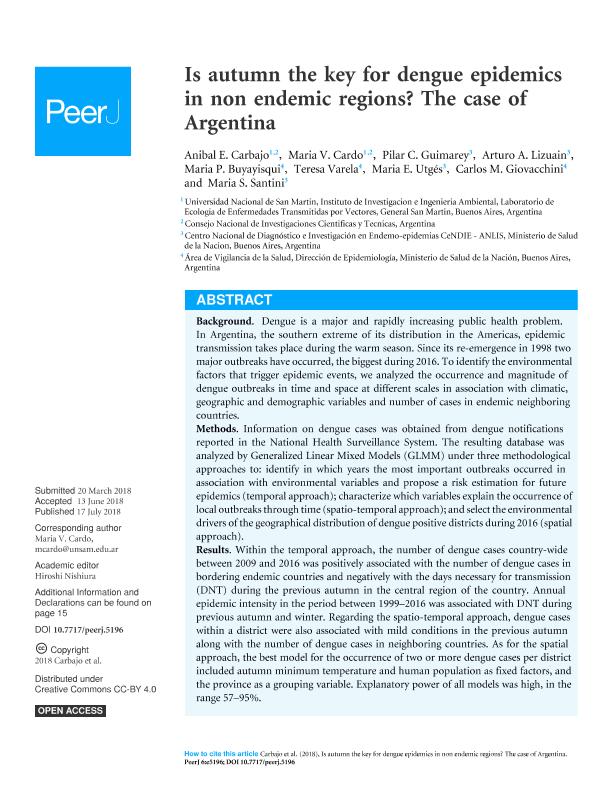Mostrar el registro sencillo del ítem
dc.contributor.author
Carbajo, Anibal Eduardo

dc.contributor.author
Cardo, María Victoria

dc.contributor.author
Guimarey, Pilar Consuelo

dc.contributor.author
Lizuain, Arturo Andrés

dc.contributor.author
Buyayisqui, María Pía

dc.contributor.author
Varela, Teresa
dc.contributor.author
Utgés, Maria E.
dc.contributor.author
Giovacchini, Carlos

dc.contributor.author
Santini, Maria Soledad

dc.date.available
2022-11-10T11:51:22Z
dc.date.issued
2018-07
dc.identifier.citation
Carbajo, Anibal Eduardo; Cardo, María Victoria; Guimarey, Pilar Consuelo; Lizuain, Arturo Andrés; Buyayisqui, María Pía; et al.; Is autumn the key for dengue epidemics in non endemic regions? The case of Argentina; PeerJ Inc; PeerJ; 7; 7-2018; 1-20
dc.identifier.issn
2167-8359
dc.identifier.uri
http://hdl.handle.net/11336/177225
dc.description.abstract
Background. Dengue is a major and rapidly increasing public health problem. In Argentina, the southern extreme of its distribution in the Americas, epidemic transmission takes place during the warm season. Since its re-emergence in 1998 two major outbreaks have occurred, the biggest during 2016. To identify the environmental factors that trigger epidemic events, we analyzed the occurrence and magnitude of dengue outbreaks in time and space at different scales in association with climatic, geographic and demographic variables and number of cases in endemic neighboring countries. Methods. Information on dengue cases was obtained from dengue notifications reported in the National Health Surveillance System. The resulting database was analyzed by Generalized Linear Mixed Models (GLMM) under three methodological approaches to: identify in which years the most important outbreaks occurred in association with environmental variables and propose a risk estimation for future epidemics (temporal approach); characterize which variables explain the occurrence of local outbreaks through time (spatio-temporal approach); and select the environmental drivers of the geographical distribution of dengue positive districts during 2016 (spatial approach). Results. Within the temporal approach, the number of dengue cases country-wide between 2009 and 2016 was positively associated with the number of dengue cases in bordering endemic countries and negatively with the days necessary for transmission (DNT) during the previous autumn in the central region of the country. Annual epidemic intensity in the period between 1999-2016 was associated with DNT during previous autumn and winter. Regarding the spatio-temporal approach, dengue cases within a district were also associated with mild conditions in the previous autumn along with the number of dengue cases in neighboring countries. As for the spatial approach, the best model for the occurrence of two or more dengue cases per district included autumn minimum temperature and human population as fixed factors, and the province as a grouping variable. Explanatory power of all models was high, in the range 57-95%. Discussion. Given the epidemic nature of dengue in Argentina, virus pressure from endemic neighboring countries along with climatic conditions are crucial to explain disease dynamics. In the three methodological approaches, temperature conditions during autumn were best associated with dengue patterns. We propose that mild autumns represent an advantage for mosquito vector populations and that, in temperate regions, this advantage manifests as a larger egg bank from which the adult population will re-emerge in spring. This may constitute a valuable anticipating tool for high transmission risk events.
dc.format
application/pdf
dc.language.iso
eng
dc.publisher
PeerJ Inc
dc.rights
info:eu-repo/semantics/openAccess
dc.rights.uri
https://creativecommons.org/licenses/by-nc-sa/2.5/ar/
dc.subject
AEDES AEGYPTI
dc.subject
ARBOVIRUS
dc.subject
CLIMATE
dc.subject
DEMOGRAPHY
dc.subject
EPIDEMIOLOGY
dc.subject
PREDICTIVE MODELS
dc.subject.classification
Epidemiología

dc.subject.classification
Ciencias de la Salud

dc.subject.classification
CIENCIAS MÉDICAS Y DE LA SALUD

dc.title
Is autumn the key for dengue epidemics in non endemic regions? The case of Argentina
dc.type
info:eu-repo/semantics/article
dc.type
info:ar-repo/semantics/artículo
dc.type
info:eu-repo/semantics/publishedVersion
dc.date.updated
2022-11-08T14:02:44Z
dc.journal.number
7
dc.journal.pagination
1-20
dc.journal.pais
Estados Unidos

dc.description.fil
Fil: Carbajo, Anibal Eduardo. Universidad Nacional de San Martín. Instituto de Investigación en Ingeniería Ambiental; Argentina. Consejo Nacional de Investigaciones Científicas y Técnicas; Argentina
dc.description.fil
Fil: Cardo, María Victoria. Universidad Nacional de San Martín. Instituto de Investigación en Ingeniería Ambiental; Argentina. Consejo Nacional de Investigaciones Científicas y Técnicas; Argentina
dc.description.fil
Fil: Guimarey, Pilar Consuelo. Dirección Nacional de Instituto de Investigación.Administración Nacional de Laboratorios e Institutos de Salud "Dr. Carlos G. Malbrán"; Argentina
dc.description.fil
Fil: Lizuain, Arturo Andrés. Dirección Nacional de Instituto de Investigación.Administración Nacional de Laboratorios e Institutos de Salud "Dr. Carlos G. Malbrán"; Argentina
dc.description.fil
Fil: Buyayisqui, María Pía. Ministerio de Salud de la Nación; Argentina
dc.description.fil
Fil: Varela, Teresa. Ministerio de Salud de la Nación; Argentina
dc.description.fil
Fil: Utgés, Maria E.. Dirección Nacional de Instituto de Investigación.Administración Nacional de Laboratorios e Institutos de Salud "Dr. Carlos G. Malbrán"; Argentina
dc.description.fil
Fil: Giovacchini, Carlos. Ministerio de Salud de la Nación; Argentina
dc.description.fil
Fil: Santini, Maria Soledad. Dirección Nacional de Instituto de Investigación.Administración Nacional de Laboratorios e Institutos de Salud "Dr. Carlos G. Malbrán"; Argentina. Consejo Nacional de Investigaciones Científicas y Técnicas; Argentina
dc.journal.title
PeerJ
dc.relation.alternativeid
info:eu-repo/semantics/altIdentifier/url/https://peerj.com/articles/5196
dc.relation.alternativeid
info:eu-repo/semantics/altIdentifier/doi/http://dx.doi.org/10.7717/peerj.5196
Archivos asociados
